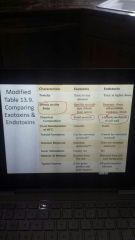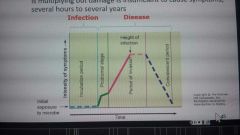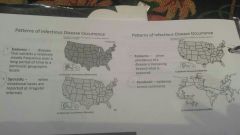![]()
![]()
![]()
Use LEFT and RIGHT arrow keys to navigate between flashcards;
Use UP and DOWN arrow keys to flip the card;
H to show hint;
A reads text to speech;
60 Cards in this Set
- Front
- Back
|
Flora |
Refers to microbiota where normally in nature flora refers to plants, and fauna refers to animals |
|
|
Resident flora |
Natural communities of microbes that become established in and on us |
|
|
Transient flora |
Microbes occupy the body for only short periods (hours two weeks) |
|
|
Symbiotic relationship |
Organisms exist together and that may or may not be a beneficial relationship - mutualism- benifits both organisms - commensailism- only benificial to one organism - parasitism - one benifits, one is harmed |
|
|
Probiotics |
Introducing known microbes back into the body |
|
|
What type of bacteria is often found on the skin? |
Gram positive bacteria |
|
|
Staphylococcus aureus |
Lower GI |
|
|
Staphylococcus epidermis |
Bacteria found on the skin, conjuntiva, nose, pharynx , mouth , outer opening of the urethra, and the vagina. |
|
|
Streptococcus mutans |
Mouth |
|
|
Streptococcus pneumoniae |
50% pharynx and 50% mouth |
|
|
Enterobacteriaceae (E. Coli) |
Lower GI |
|
|
Bifidobacterium bifidum |
Lower GI |
|
|
Lactobacillus sp. |
Mouth and lower GI |
|
|
Where do newborns first get contaminated prior to birth. |
They are germ free prior, first exposure comes from the breaking of fetal membrane. |
|
|
Infection |
Invasion of pathogenic microbes may result in eventual disease. |
|
|
Disease |
Loss of homeostasis in the body from various causes. |
|
|
Pathogen |
A microbe that can cause disease |
|
|
True or primary pathogens |
Capable of causing disease in healthy persons with normal immune diseases |
|
|
Opportunistic pathogens |
Cause disease when the host defenses are compromised or when they grow in part of the body that is not natural to them |
|
|
Pathogenesis |
Stepwise progression of the host-pathogen events during disease. How does it get into the body and cause disease. |
|
|
Pathogenicity |
Inherent or genetic ability of a pathogen to inflict damage to host , may or may not occur or be expressed. |
|
|
Virulence |
The amount of variance factors being expressed by the microbe during specific host-pathogen interactions. What are the tools that makes this a pathogen. |
|
|
Virulence factors |
Physical / biochemical characteristics that enhance the ability to inflict damage and cause disease. - factors that is used for mobility - factors used for attachment - factors that helped spread between tissue cells - factors that help penetrate inside host tissue and kill cells - factors that help overcome host defenses |
|
|
Key aspects of infection |
1. Entry into specific portal into body. 2. Successful journey to specific tissue. 3. Attachment to specific tissue 4. Colonization 5. Infect damage to cells and possibly spread. |
|
|
Exogenous agents |
Originate from source outside the body. |
|
|
Endogenous agents |
Already exist on or in the body (normal flora) |
|
|
Storch agents |
Things that can cross the plecenta - syphilis - taxoplasmosis - other diseases (hep b, aids, and chlamydia ) - rubella Cytomegalovirys and herpes simplex virus |
|
|
Colonization |
Population increase to infectious does or beyond while overcoming host defenses |
|
|
Inflict damage to cells and possibly spread |
Pathogens can be non-invasive or invasive (enter inside host cells) |
|
|
Antipgagocytic factors |
Used to avoid death be phaygocytosis. Causes phaygocytosis l, but blocks phaygocytes ability to cause death (microbes hiding inside) |
|
|
Leukocidins |
Toxic that destroy white blood cells -Staphylococcus and Streptococcus spp. |
|
|
Slime layor or capsule |
Makes phaygocytosis difficult and imparts an ability to survive intracellular phaygocytosis |
|
|
Coagulase |
Forms fibrin clots (microbes hiding inside) - Staphylococcus spp. |
|
|
Coagulase (staphylococcus sp.) (Virulence factor) |
Forms a fibrin clot in host, protects organism from phagocytic cells |
|
|
Streptokinase (Streptococcus sp.) (Virulence factor ) |
Dissolves fibrin clots in host, allows spread of organism to other sites. |
|
|
Exoenzymes |
Dissolve extracellular barriers and penetrate through or between cells |
|
|
Toxins |
Produce toxins at the site of multiplication |
|
|
Hyaluronidase (bacterial enzyme aids in spreading) |
Gets past sent cells digests hyaluronic acid and allows tissue penitration. (Staphylococcus , Streptococcus, Clostridium ) |
|
|
Hemolysin |
Dissolve host blood cells and release iron for bacterial metabolism(nutrient for organism) ( Staphylococcus, Streptococcus, Clostridium) |
|
|
Bacterial toxins (Exotoxins) |
Get into the body and have specific targets lock and key fit. |
|
|
Bacterial toxins, (Endotoxins) |
Break up toxin gets into the body (toxin is not suposed to be there so causes general physiological effects not specific tissue. |
|

Know this information |
Effects on the body Chemical composition Fever stimulation Typical sources (Know general concept of endo and exo) |
|
|
Prodromal stage |
Vage feelings of discomfort nonspecific complaints. |
|
|
Piriod of invasion |
Step 3 ... multiplies at high levels, becomes well-established; more specific signs and symptoms. |
|

Incubation period |
Time from initial contact with the infectious agent to the appearance of the first symptom agent is multiplying but damage is insufficient to cause sometimes several hours to several years |
|
|
Convalescent period |
As person begins to respond to the infection, symptoms decline. |
|
|
Localized infection |
Microbes enter the body and remains confined to a specific tissue. |
|
|
Systemic infection |
Infection spreads to several sites and tissue fluid usually in the bloodstream. |
|
|
Mixed infection |
Several microbes grow simultaneously at the infection site. |
|
|
Primary infection |
Initial infection |
|
|
Secondary infection |
Another infection by a different microbe |
|
|
Sequelae |
Another infection from same microbe |
|
|
Acute infection |
Comes on rapidly, with severe but short-lived effects |
|
|
Chronic infections |
Progressing persist over a long period of time |
|
|
Signs |
What the doctor can detect or measure objective examples doctor feels warm skin doctor sees trembling. |
|
|
Symptoms |
What's a patient notices or feels subjective patient feels hot patient experiencing nervousness. |
|
|
What are the 6 biggest nosocomial infections? |
Urinary Lower resp tract Surgical wounds Other Skin Blood (In order from biggest % to smallest) |
|
|
Transmission patterns (Direct contact) |
Physical contact with infected individual/animal or large droplet that travel short distances. (Comes from reservoir - trensmision- individual) |
|
|
Transmission patterns (indirect contact) |
Passes from infected how to intermediate conveyor fomites, food, aerosols, droplet nuclei and then to another host. **can occur in the absence of the infected individual flash animal** route (reservoir - transfer- source- transfer -individual ) |
|

Know these |
Disease occurrences |

